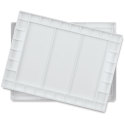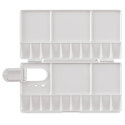
If you’ve just purchased some new watercolor tubes, you’re likely going to need a watercolor palette…
But how can you be sure you’re choosing the right one for YOU?
This post was written for those of you who are not sure where to get started in choosing a new palette! I will go over a few recommendations and what to look for when buying one.
Please note: This article may contain affiliate links. If you choose to purchase something I will earn a small commission at no extra cost to you. You can learn more by reading the full disclosure here.
5 Excellent Empty Palettes You Can Buy Online
1. Masterson Aqua-Pro Watercolor Palette

The Aqua-Pro is made from high-quality, stain-resistant, injection molded resins. It has 32 wells and a large mixing area that is divided into three sections. It comes with a leak-proof lid that snaps on tightly and can be used as an extra mixing area!
Pros– A large number of paint wells; Large mixing area; Comes with a cover; paint wells are easily accessible, leak proof.
Con’s– Its large size makes it difficult to take with you on the go. Some reviewers complained of an inconsistent well design (some wells were slanted and others were not). Although the paints don’t leak out of the cover, wet paints may intermix (this can be solved if you let them dry before closing.)
2. Masters International Folding Watercolor Palette

If you’re just getting started and willing to compromise on quality you can always opt for this palette then plan to upgrade later on.
Features: 20 wells, 5 mixing areas, plastic based.
Pros: It has a large mixing area, and lots of wells so you can include many colors. The palette itself is light and portable. Not to mention it is far cheaper than the other palettes.
Cons: Not airtight or leak-proof which means you can get dust inside. The palette is made from plastic, so the surface will stain over time. The wells are not very deep, this means they hold less paint. It is, however, a better affordable option.
3. Tom Lynch Porcelain Palette

This palette is great for studio use. Unlike many other porcelain palettes, this one comes with a cover designed to protect the paint from dust and dirt during storage. This makes it an excellent choice!
Pro’s- Does not stain, durable and long-lasting, large mixing area, comes with a lid, comes with many wells (20), comes with brush holders.
Con’s- heavy, not ideal for taking on the go, and the lid is made of plastic.
4. Empty Watercolor Palette Tins

Features: Made with metal, the pans can be removed to reveal an extra mixing area. Available for 12, 24, and 48 half pans. The folding lid makes it easier to keep the paints free of dirt which is a huge plus!
Pro’s- cheaper than other metal box palettes, large mixing area, light, and portable, easy to customize, and comes in different sizes including a small travel pocket size.
Con’s- Staining, not as sturdy as other metal boxes, does not come with empty pans.
5. Richeson Nesting Porcelain Palette Sets

Also an excellent choice for the studio these Richeson Porcelain sets will last you a long time. You get plenty of mixing space in each dish. Each set comes with 5 dishes that stack on top of each other neatly with 1 cover.
Pros- Long-lasting, non-staining, easy to clean. The round dishes stack up neatly. Each set comes with 1 cover lid so you can preserve paint for a long time to come. Small and large size options.
Con’s- Heavy, not made to carry on the go, no separate wells to store different colors.
What to consider when buying a watercolor palette?
Palette material
When purchasing a palette for your watercolors you need to know the three main materials used to make them. Each has its advantages and disadvantages.
Ceramic or porcelain- these palettes are both clay-based and kiln-fired (kiln-fired refers to a special type of oven used to heat materials made of clay or mud such as ceramics and bricks). However, porcelain palettes are made using dense clay and are heated for longer at a higher temperature than ceramic. This makes them slightly sturdier.
Metal– Most commonly available in the form of trays and tin boxes that can fit half pans or full pans of paint.
Plastic– Come in different sizes, most of the time with covers and large mixing areas and slanted wells.
| Ceramic or porcelin | Metal | Plastic | |
| Advantages | -Easy to clean -Don’t stain easily -You can see the colors very well when mixing -Paint stays in one puddle instead of breaking into tiny beads -Larger mixing areas | -lighter in weight, easy to travel with -cheaper -Portable -come with cover | -most plastic palettes are portable -lighter in weight, easy to travel with -comes with a cover as mixing area |
| Disadvantages | – Heavy -expensive -Most come without a lid, allowing dust and dirt to accumulate in the wells | -stain easily -small wells -paint separates into tiny beads when mixing | -stain easily -harder to clean -paint separates into tiny beads when mixing |
Number of wells
You’ll have to consider the number of wells depending on how many colors you wish to have in one palette. I would recommend getting one with 16-18 wells. You can add find a palette with 24 incase you hope to make changes in the future (add a new color…etc), it doesn’t hurt to have some empty wells.
Metal palettes come in the form of a tin box with tiny half pans or full pans (Full pans hold around 3ml while half pans hold around 1.5ml of paint). Buying a palette with half or full pans makes it much easier to make changes (removing or adding colors). I suggest going for full pans, this is because you don’t want to damage your brush by digging into tiny half pans.
Size and shape of wells
The size of the wells matter because you don’t want to purchase a palette where the size of the wells don’t correlate with the size of your brushes. For example you’ll have a difficult time loading a size 1 hake brush from a half pan…
Different palettes have differently shaped wells. Aside from the rectangle pans, you can also get palettes with round smooth semi circles or slanted wells.
Not to mention you can cause damage to your brushes and reduce their lifetime.
If you are used to working on large paintings then a studio ceramic palette could be the option for you.
Cover/no cover?
Watercolors don’t require a lid to keep the paint moist like acrylics because they can be re-activated with water. However, if you are used to traveling with your paints and doing some Plein-air work a lid can be crucial. It’ll also keep your paints safe from gathering dirt and dust.
Ceramic palettes don’t always come with a lid, this is because they are designed for working in the studio. However, you can always try looking for some that have a lid. Most metal and plastic palettes do however come with a lid.
*Note: Although some palettes that come with a cover remember to allow the paints time to dry before transporting the palette. This will prevent the colors from intermixing.
Mixing area?
How big of a mixing area do you prefer? Generally speaking, ceramic/porcelin palettes have the largest mixing areas. However you can also find plastic palettes with large mixing areas too. It all depends on personal preference and how large your brushes and paintings are.
I hope you enjoyed this post and found it helpful! You can check out my posts on watercolor supplies here.
